It can cause death or the sloughing off of feet, tail or ears.
There may or may not be long-term health consequences, but marketability can be affected due to shorter tails or shorter ears.
It is frustrating for producers when perfectly healthy short-eared or shorter-tailed calves have to be sold at a discount price come fall.
Many frostbitten calves are born early and arrive unexpectedly, especially if it’s a particularly cold night and they are born in the middle of the night.
Producers should be cognizant of any twins being born, the potential for early arriving calves or a cow bagging up (developing a full udder) well ahead of time.
Moving the calving period to spring helps avoid low temperatures, but many purebred breeders still calve early in the year.
These producers usually have well-bedded areas and barns with surveillance cameras and they increase the frequency of calving checks during cold weather to prevent frostbitten calves.
Calves most susceptible to frostbite are ones that calve quickly shortly after a check. Frostbite can occur in a matter of minutes. With wet and thin prominent ears, it is no wonder frostbite gets the ears fast.
Getting the mother and calf in a shelter with lots of bedding goes without saying. As well, a warmer barn until they are dried off and the calf is suckling is a huge help. This is where extra labour and time can pay big dividends, with fewer frozen limbs, ears, tails, and less pneumonia. By helping to get the calf suckling in a warm barn, the calf also gets its first colostrum and healthy antibodies from its mother.
There is no doubt that a cold newborn calf is less likely to suckle quickly and it runs a much higher risk of getting sick. I am thinking of scours, pneumonia and navel infections.
Newborns pose the greatest risk but following that group, calves a few days old can have ill-thrift and poor circulation, thin haircoats or overzealous mothers that want to lick them incessantly.
Earmuffs pose little benefit unless used by one that has already had frozen ears because mothers tend to try and lick them off.
There should not be any muffs used on testicles of bulls. That practice was dismissed several years ago. While frost damage occurs on bull testicles on occasion, if the animal is well-bedded so no manure gets stuck to the bottom of the scrotum, and the bulls pull up their testicles, the risk of damage from frostbite, even in very cold weather, is minimal.
Porosity fences where all cattle can get protection helps greatly with frozen testicles in bulls or frozen teats on cows.
Cow udders can be damaged by cold, usually during the windy days with no protection.
Recognizing the calves that are sick or dehydrated and seeing the need to get them in a protected area can make a huge difference.
The cold makes recovery more difficult. In colder weather, some cows, especially first-calf heifers, are slow at licking their calves off or they ignore them.
Recognizing this and making sure colostrum is supplied while keeping these calves in a warmer area for an extra day can return huge dividends.
We all have a process at calving and if we recognize those that need that extra TLC, we can eliminate unnecessary deaths, frostbite, and some calf diseases.
Even on later calving farms, a freak snow storm in late April or May can make calves wet, hypothermic and prone to these conditions too.
Having a creep type area that is well-wooded or an area that a calf can go that is considerably drier and warmer can help. Calves are smart, and we see that 90 percent of them in a pen of 50 pairs will be in the creep area on cold nights.
The bedding stays clean and the calves and cows are under minimal stress. This leads to healthier, growthier calves down the line.
Producers should pay close attention to ambient temperatures in cases where calves have a cast or splint on their legs, have contracted tendons or in cases of calves with obturator paralysis conditions in which they can’t get their legs under their body when lying down. This presents a very high risk case for frostbite.

